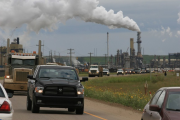Amid all the controversy over pipeline projects recently, one critical fact is being overlooked: government regulators have already approved more than 5 million barrels per day of oilsands production, and we could reach that milestone just over two decades from now.
That’s triple the current rate of oilsands production, a level of expansion that has been approved despite widespread recognition that the environmental costs of our current approach to oilsands extraction are unacceptably high, and major improvements to both government oversight and industry operations are required.
It’s an important fact to keep in mind every time the federal government, the government of Alberta, or the oilsands industry’s lobby group say they are committed to “responsible oilsands development” while pushing for unfettered expansion and reduced regulation.
And it helps to explain what’s at stake in the current pipeline debate: without new pipelines, such rapid oilsands expansion would be futile, because companies would be unable to get their product to market.
But locking in the infrastructure that would support 5 million barrels per day of oilsands production would also lock in the corresponding increase in environmental harm, unless companies are required to make major improvements to current business practices and technologies as a condition to this expansion.
In other words, the pipeline debate is critical not just because of the potential for pollution from spills and tanker accidents, but because the decisions we make today about how and where bitumen is transported will set the course for the environmental and climate impacts from oilsands production for the decades ahead.
As an Alberta-born and bred organization keen to advance solutions to the growing regional and climate impacts of oilsands production, we think it’s time to revisit the definition of responsible resource development in the context of current and future oilsands development.
The Pembina Institute introduced the notion of “responsible” oilsands development long before industry and governments were branding their energy development plans with the term. So in theory, it appears we’ve finally found an approach to oilsands development that we can all agree on.
The test is whether we agree on what “responsible” oilsands development would actually look like.
More than five years ago, we released a blueprint for responsible oilsands production that included the following elements:
- Limit environmental impacts: Apply science-based precautionary limits that tell us when ecosystems are threatened, so that we can make informed decisions about whether and how oilsands projects proceed.
- Address cumulative impacts: Improve the systems and approaches for monitoring and addressing the impacts of oilsands development on the climate, air, fresh water, boreal forest and wildlife.
- Focus on quality of life: Manage the rate of oilsands growth to maximize the benefits to Albertans' quality of life, and ensure that social services and infrastructure can keep pace.
- Make better decisions for Albertans: Reform the decision-making process so that the public interest comes first and only responsible oilsands projects proceed.
- Plan for the future: Take advantage of Alberta's prosperity so as to build a more diversified, green and competitive future that includes low-impact renewable energies and responsible energy use.
At the time, we considered it a blueprint for ambitious but achievable changes — actions that would enable Alberta and Canada to credibly claim that it was acting as a responsible steward and developer of the third-largest oil reserve in the world.
Last year we went a step further by outlining 19 policy solutions aiming to protect air, forests, wildlife and fresh water, along with a credible approach to reducing greenhouse gas pollution and establishing a world-class environmental monitoring system.
And earlier this year, we explored the economic downsides of red-hot oilsands development and the shift that is making our national economy increasingly dependent on oil exports. We examined the unintended economic consequences of ramping up oilsands development, and suggested changes to minimize these negative side effects and ensure the economic potential of this resource isn’t squandered.
Here’s the bottom line: there is an urgent need to manage the pace and scale of oilsands development much more deliberately, and simply branding that development “responsible” doesn’t make it so.
We’re already witnessing the environmental problems associated with drawing 1.7 million barrels of bitumen out of the ground in northeastern Alberta: contamination of forests, wetlands and rivers; declining caribou populations; and steadily increasing greenhouse gas pollution, to name just a few.
It’s difficult to see how 5 million barrels a day of oilsands production can be achieved responsibly — particularly when the federal government is weakening regulatory oversight, and oilsands approvals are proceeding despite incomplete information about current impacts and without requiring companies seeking project approvals to improve on current practices as a condition of expansion.
Fixing the problems associated with toxic tailings ponds, declining caribou and lagging land reclamation requires time. The approach of letting the market dictate the pace and scale of development — rather than proactively managing to minimize harm and maximize benefits — has failed.
The numbers don't lie. If oilsands operators achieve or exceed the 5 million barrels per day of production that has already been approved without making major changes that aren’t even on the drawing board today, “responsible resource development” will be out of reach. As far as slogans go, it’s a great catch phrase. The challenge for governments and the oilsands industry now is to demonstrate they can — and intend to — deliver.





